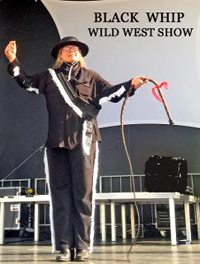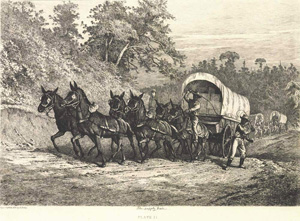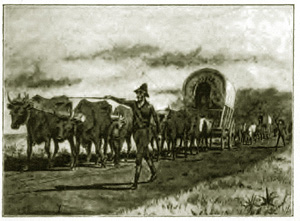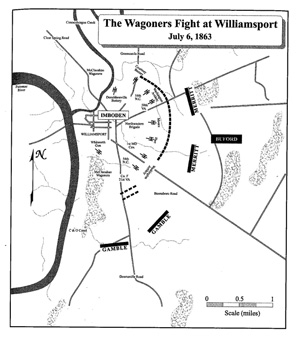
The President’s Message:
Thank you to Harold Teltser, Ted Gerson, and Joel Gordon for supplying
the refreshments in June, July, and August. Your generosity is greatly
appreciated.
If you have any ideas for programs, please contact me.
Gerridine LaRovere
July 11, 2018 Program:
Peppy
Lizza was a former member of the PBCCWRT and has returned to us.
He has done many programs and will do this month's on the importance of
Civil War Music. Join him as he surveys the " Top Ten " hits from the
60's...well, the 1860's. He will also select songs that were oldies at
that time, as well as heartfelt ones that are still sung today.
June 13, 2018 Program:
 Cinthia
Morrison gave a presentation entitled:
Teamsters, Muleskinners, and Bullwhackers of the Civil War.
The North used railroads to carry men, heavy weapons, and other
supplies. But each army had
to carry with them supplies to use on a daily basis.
Those supplies were carried in supply trains.
Supply trains were made up of wagons, horses, mules, and
teamsters who were the drivers.
When a wagon was empty, the teamster was sent back to a supply
base to reload and return to the march or the camp.
A teamster had to reload his wagon with the same type of supply
he had carried before.
General Sherman's supply train consisted of over 5,000 wagons, 800
ambulances, 28,000 horses, and 32,000 mules.
His supply train stretched for miles, as did many supply trains
that served the Northern regiments. Cinthia
Morrison gave a presentation entitled:
Teamsters, Muleskinners, and Bullwhackers of the Civil War.
The North used railroads to carry men, heavy weapons, and other
supplies. But each army had
to carry with them supplies to use on a daily basis.
Those supplies were carried in supply trains.
Supply trains were made up of wagons, horses, mules, and
teamsters who were the drivers.
When a wagon was empty, the teamster was sent back to a supply
base to reload and return to the march or the camp.
A teamster had to reload his wagon with the same type of supply
he had carried before.
General Sherman's supply train consisted of over 5,000 wagons, 800
ambulances, 28,000 horses, and 32,000 mules.
His supply train stretched for miles, as did many supply trains
that served the Northern regiments.
A horse can generally pull three times its weight on good surfaces, two
times its weight on bad or hilly surfaces.
Since the average horse weighs about 900 to 1,100 pounds that's
about 3,000 pounds on good roads, 1,900 on bad roads, and maybe 1,000 on very bad
roads or steep ground.
pounds on good roads, 1,900 on bad roads, and maybe 1,000 on very bad
roads or steep ground.
At best a battery could make about five miles an hour on good, level
surfaces and with good horses but not for sustained periods.
About two miles per hour for six hours (i.e. 15 miles per day)
would have been average and twenty to twenty-five miles per day would
have been the typical maximum.
The average artillery horse lasted about eight months.
Teamsters of the day can be divided by the animals they drove.
The muleskinners worked the mule
 teams.
They usually rode on the backs of the last set of animals in the
team as illustrated in the image.
Bullwhackers drove teams of oxen.
Unlike the muleskinners, they walked beside their teams. teams.
They usually rode on the backs of the last set of animals in the
team as illustrated in the image.
Bullwhackers drove teams of oxen.
Unlike the muleskinners, they walked beside their teams.
Cindy touched briefly on teamsters in Florida.
In hopes of disrupting food supplies to the Confederate troop,
the blockading ships around the coast of Florida sent raider up the bays
and streams. Of necessity
these raids were small in number as they had to come inland by small
draft boats. To counter
this threat, the ranchers formed military units referred to as the “cow
cavalry.”
The last story she related to us was about the role BG John Imboden
played in the retreat from Gettysburg.
Lee’s army was up against a high river near Williamsport, PA.
Improvising reinforcements, Imboden organized about 700 of his
wagoners into infantry companies under wounded officers, and
commissaries and quartermasters.
He positioned these makeshift soldiers on his right and left
flanks and then bolstered the center of his line with 2,100 dismounted
cavalrymen and 24 cannons, establishing a three-mile perimeter on a
crescent-shaped ridge a half-mile west of Williamsport.
There they held off the Union cavalry under the command of BG
John Buford. For a more
complete story about this engagement see The
Retreat from Gettysburg
below. This has been
reproduced from Imboden’s own memoirs written in 1887.
At the end of her presentation, Cindy put on a demonstration of whip
artistry. While explaining
that the whip was not to beat the animals, but to get their attention.
The crack of a whip is actually a sonic boom as the end of the
whip goes supersonic. She
gave hints of her very colorful past as an escape artist, a ren-faire
performer, a knife thrower, and of course whip artist.
Ms. Morrison’s talk was applauded at its conclusion.
The Retreat from Gettysburg, by Brig. General John Imboden C.S.A. (1887)
During the Gettysburg campaign, my command an independent brigade of
cavalry was engaged, by General Lee’s confidential orders, in raids on
the left flank of his advancing army, destroying railroad bridges and
cutting the canal below Cumberland wherever I could so that I did not
reach the field till noon of the last day’s battle. I reported direct to
General Lee for orders and was assigned a position to aid in repelling
any cavalry demonstration on his rear. None of a serious character being
made, my little force took no part in the battle, but was merely
spectators of the scene, which transcended in grandeur any that I beheld
in any other battle of the war.
When night closed the struggle, Lee’s army was repulsed. We all knew
that the day had gone against us, of the disaster was only known in high
quarters. The carnage of the day was generally understood to have been
frightful, yet our army was not in retreat, and it was surmised in camp
that with tomorrow’s dawn would come a renewal of the struggle. All felt
and appreciated the momentous consequences to the cause of Southern
independence of final defeat or victory on that great field.
[Editor’s note: The next
paragraphs tell about Lee’s orders for retreat and Imboden’s wagon
command.]
Shortly after noon of the 4th the very windows of heaven seemed to have
opened. The rain fell in blinding sheets; the meadows were soon
overflowed, and fences gave way before the raging streams. During the
storm, wagons, ambulances, and artillery carriages by hundreds by
thousands were assembling in the fields along the road from Gettysburg
to Cashtown, in one confused arid apparently inextricable mass. As the
afternoon wore on there was no abatement in the storm. Canvas was no
protection against its fury, and the wounded men lying upon the naked
boards of the wagon bodies were drenched. Horses and mules were blinded
and maddened by the wind and water and became almost unmanageable. The
deafening roar of the mingled sounds of heaven and earth all around us
made it almost impossible to communicate orders, and equally difficult
to execute them.
About 4 P. M. the head of the column was put in motion near Cashtown and
began the ascent of the mountain in the direction of Chambersburg. I
remained at Cashtown giving directions and putting in detachments of
guns and troops at what I estimated to be intervals of a quarter or a
third of a mile. It was found from the position of the head of the
column west of the mountain at dawn of the 5th, the hour at which
Young’s cavalry and Hart’s battery began tile assent of the mountain
near Cashtown, that the entire column was seventeen miles long when
drawn out on the road and put in motion. As an advance guard I had
placed the 18th Virginia Cavalry, Colonel George W. Imboden in front
with a section of McClanahan’s battery.
Next to them, by request, was placed an ambulance carrying, stretched
side by side, two of North Carolina’s most distinguished soldiers,
Generals Pender and Scales, both badly wounded, but resolved to bear the
tortures of the journey rather than become prisoners. I shared a little
bread and meat with them at noon, and they waited patiently for hours
for the head of the column to move. The trip cost poor Pender his life.
General Scales appeared to be worse hurt, but stopped at Winchester,
recovered, and fought through the war.
[Editor’s note: The next
paragraphs tell about the pitiful condition of the wounded.]
We were now twelve or fifteen miles from the Potomac at Williamsport,
our point of crossing into Virginia.
Here our apprehended troubles began. After the advance of the
18th Virginia Cavalry had passed perhaps a mile beyond the town, the
citizens to the number of thirty or forty attacked the train with axes,
cutting the spokes out of ten or a dozen wheels and dropping the wagons
in the streets. The moment I heard of it I sent back a detachment of
cavalry to capture every citizen who had been engaged in this work and
treat them as prisoners of war. This stopped the trouble there, but the
Union cavalry began to swarm down upon us from the fields and
crossroads, making their attacks in small bodies, and striking the
column where there were few or no guards, and thus creating great
confusion. I had a narrow escape from capture by one of these parties of
perhaps fifty men that I tried to drive off with canister from two of
McClanahan’s guns that were close at hand. They would perhaps have been
too much for me; had not Colonel Imboden, hearing the firing turned back
with his regiment at a gallop, and by the suddenness of his movement
surrounded and caught the entire party.
To add to our perplexities still further, a report reached me a little
after sunrise, that the Federals in large force held Williamsport. I did
not fully credit this and decided to push on. Fortunately, the report
was untrue. After a great deal of desultory fighting and harassments
along the road during the day, nearly the whole of the immense train
reached Williamsport on the afternoon of the 5th. A
 part
of it, with Hart’s battery, came in next day, General Young having
halted and turned his attention to guarding the road from the west with
his cavalry. We took possession of the town to convert it into a great
hospital for the thousands of wounded we had brought from Gettysburg. I
required all the families in the place to go to cooking for the sick and
wounded, on pain of having their kitchens occupied for that purpose by
my men. They readily complied. A large number of surgeons had
accompanied the train, arid these at once pulled off their coats and
went to work and soon a vast amount of suffering was mitigated. The
bodies of a few who had died on the march were buried. All this became
necessary because the tremendous rains had raised the river more than
ten feet above the fording stage of water, and we could not possibly
cross then. There were two small ferryboats or “flats” there, which I
immediately put into requisition to carry across those of the wounded,
who, after being fed and having their wounds dressed, thought they could
walk to Winchester. Quite a large number were able to do this, so that
the “flats” were kept running all the time. part
of it, with Hart’s battery, came in next day, General Young having
halted and turned his attention to guarding the road from the west with
his cavalry. We took possession of the town to convert it into a great
hospital for the thousands of wounded we had brought from Gettysburg. I
required all the families in the place to go to cooking for the sick and
wounded, on pain of having their kitchens occupied for that purpose by
my men. They readily complied. A large number of surgeons had
accompanied the train, arid these at once pulled off their coats and
went to work and soon a vast amount of suffering was mitigated. The
bodies of a few who had died on the march were buried. All this became
necessary because the tremendous rains had raised the river more than
ten feet above the fording stage of water, and we could not possibly
cross then. There were two small ferryboats or “flats” there, which I
immediately put into requisition to carry across those of the wounded,
who, after being fed and having their wounds dressed, thought they could
walk to Winchester. Quite a large number were able to do this, so that
the “flats” were kept running all the time.
Our situation was frightful. We had probably ten thousand animals and
nearly all the wagons of General Lee’s army under our charge, and all
the wounded, to the number of several thousand, that could be brought
from Gettysburg. Our supply of provisions consisted of a few wagonloads
of flour in my own brigade train, a small lot of fine fat cattle, which
I had collected in Pennsylvania on my way to Gettysburg, and some sugar
and coffee procured in the same way at Mercersburg.
The town of Williamsport is located in the lower angle formed by the
Potomac with Conococheagne Creek. These streams enclose the town on two
sides, and back of it about one mile there is a low range of hills that
is crossed by four roads converging at the town. The first is the
Greencastle road leading down the creek valley; next the Hagerstown
road; then the Boonsboro’ road; and lastly the River road.
Early on the morning of the 6th I received intelligence of the approach
from Frederick of a large body of cavalry with three full batteries of
six rifled guns. These were the divisions of Generals Buford and
Kilpatrick, and Huey’s brigade of Gregg’s division, consisting, as I
afterward learned, of 23 regiments of cavalry, and 18 guns, a total
force of about 7000 men.
I immediately posted my guns on the hills that concealed the town, and
dismounted my own command to support them and ordered as many of the
Wagoner’s to be formed as could be armed with the guns of the wounded
that we had brought from Gettysburg. In this I was greatly aided by
Colonel J. L. Black of South Carolina, Captain J. F. Hart commanding a
battery from the same State, Colonel William II. Aylett of Virginia, and
other wounded officers. By noon about 700 Wagoner's were organized into
companies of 100 each and officered by wounded line officers and
commissaries and quartermasters, about 250 of these were given to
Colonel Aylett on the right next the river, about as many under Colonel
Black on the left, and the residue were used as skirmishers. My own
command proper was held well in hand in the center.
The enemy appeared in our front about half-past one o’clock on both the
Hagerstown, and Boonsboro’ roads, and the fight began. Every man under
my command understood that if we did not repulse the enemy we should all
be captured and General Lee’s army be ruined by the loss of its
transportation, which at that period could not have been replaced in
the Confederacy. The fight began with artillery on both sides. The
firing from our side was very rapid and seemed to make the enemy
hesitate about advancing. In a half hour J. D. Moore’s battery ran out
of ammunition, but as an ordnance train had arrived from Winchester, two
wagonloads of ammunition were ferried across the river and run upon the
field behind the guns, and the boxes tumbled out, to be broken open with
axes. With this fresh supply our guns were all soon in full play again.
As the enemy could not see the supports of our batteries from the
hilltops, I moved the whole line forward to his full view, in single
ranks, to show a long front on the Hagerstown approach. My line passed
our guns fifty or one hundred yards, where they were halted awhile, and
then were withdrawn behind the hilltop again, slowly and steadily.
Leaving Black’s Wagoner's and the Marylanders on the left to support
Hart’s and Moore’s batteries, Captain Hart having been put in command by
Colonel Black when he was obliged to be elsewhere, I moved the 18th
Virginia Cavalry and 62d Virginia Mounted Infantry rapidly to the right,
to meet and repel five advancing regiments (dismounted) of the enemy. My
three regiments, with Captain John H. McNeill’s Partisan Rangers and
Aylett’s Wagoner's, had to sustain a very severe contest. Hart, seeing
how hard we were pressed on the right, charged the enemy’s right with
his little command, and at the same time Eshleman with his eight
Napoleons advanced four hundred yards to the front, and got an
enfilading position, from which, with the aid of McClanahan’s battery,
he poured a furious fire into the enemy’s line. The 62d and Aylett,
supported by the 18th Cavalry, and McNeill, charged the enemy who fell
back sullenly to their horses.
Night was now rapidly approaching, when a messenger from Fitzhugh Lee
arrived to urge me to “hold my own,” as he would be up in a half hour
with three thousand fresh men. The news was sent along our whole line
and was received with a wild and exultant yell. We knew then that the
field was won, and slowly pressed forward. Almost at the same moment we
heard distant guns on the enemy’s rear and right on the Hagerstown road.
They were Stuart’s, who was approaching on that road, while Fitzhugh Lee
was coming on the Greencastle road. That settled the contest. The enemy
broke to the left and fled by the Boonsboro’ road. It was too dark to
follow. When General Fitzhugh Lee joined me with his staff on the field,
one of the enemy’s shells came near striking him. General Lee thought it
came from Eshleman’s battery, till, a moment later, he saw a blaze from
its gun streaming away from us.
We captured about 125 of the enemy who failed to reach their horses. I
could never ascertain the loss on either side. I estimated ours at about
125. The Wagoner's fought so well that this came to be known as “the
Wagoner's’ fight.” Quite a number of them were killed in storming a farm
from which sharpshooters were rapidly picking off Eshleman’s men and
horses.
My whole force engaged, Wagoner's included, did not exceed three
thousand men. The ruse practiced by showing a formidable line on the
left, then withdrawing it to fight on the right, together with our
numerous artillery, 23 guns, led to the belief that our force was much
greater. By extraordinary
good fortune we had thus saved all of General Lee’s trains. A bold
charge at any time before sunset would have broken our feeble lines, and
then we should all have fallen an easy prey to the Federals. The next
day our army arrived from Gettysburg, and the country is familiar with
the way it escaped across the Potomac on the night of the 13th of July.
Last changed: 06/28/18
Home
About News
Newsletters
Calendar
Memories
Links Join
|

